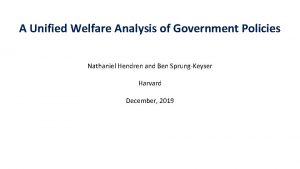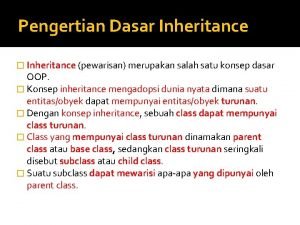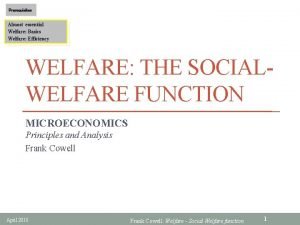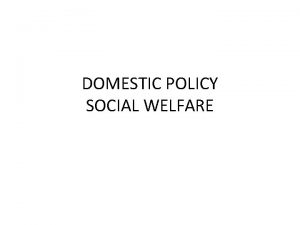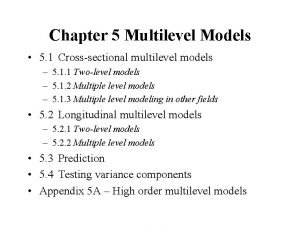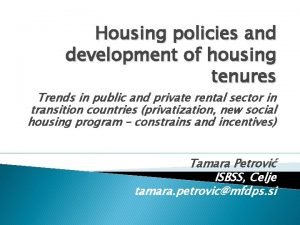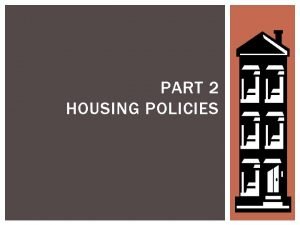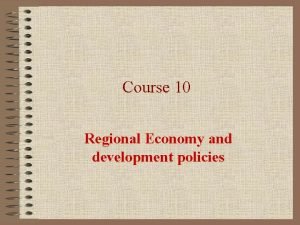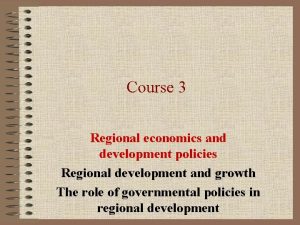Multilevel welfare and housing regional housing policies in

























- Slides: 25

Multi-level welfare and housing: regional housing policies in the Spanish home ownership society Joris Hoekstra - OTB Research for the Built Environment / Delft University of Technology Challenge the future

Aitziber Etxezarreta Gala Cano Fuentes Estrella Cruz Mazo Kees Dol and Joris Hoekstra 2|

Goal of the research To what extent do patterns of multi-level governance influence Spanish housing policy? • To what extent do regional policies drift away from the national housing policy? • What is the influence of regional affluence, historical identity and political ideology? Why? Subject of multi-level governance gets little attention in housing studies 3|

Structure of the presentation 1. Multi-level governance: theoretical concepts 2. Spanish national housing and the influence of the GFC 3. Post-crisis regional housing policies (Basque Country, Andalucía) 4. Conclusions and recommendations for further research 4|

Multi-level governance (1) European Union Nation States Regions Provinces Municipalities Countries with strong competencies at the regional level: Spain, Germany, Italy, UK, Belgium 5|

Multi-level governance (2) European Union Nation States Regions Europeanization contributes to regionalization: • Regional policies of the EU • Transnational co-operation in so-called Euregions 6|

Multi-level governance (3) Multi-level governance and welfare provision. What determines at which level welfare and housing policies are carried out? 3 concepts that may explain the rise of regional welfare policies: 1. Subsidiarity 2. Retrenchment of national welfare states 3. Regional autonomy and inter-regional solidarity T 7|

Subsidiarity Organizing principle of decentralisation, stating that a matter ought to be handled by the smallest, lowest, or least centralized authority capable of addressing that matter effectively => Maastricht treaty (1992): what is EU responsibility and what is national responsibility? => Decentralization of welfare policies, ‘regional laboratories’ T 8|

Retrenchment of the welfare state Part of the responsibility for welfare policies might be transferred to the regional and/or local level in order to realize budget cuts at the national level (e. g. the decentralization of health care policies to the municipalities in the Netherlands). Regional policy-makers might attempt to repair some of the effects of national welfare state retrenchment. 9|

Regional autonomy and regional welfare policies The more regional autonomy, the higher the probability of regional welfare policies. The degree regional autonomy depends on: • Economic development of the region • The degree and nature of the regional identity • The political structure of the country (federal or not? ) 10 |

Spanish national housing policies (pre-crisis) • Mediterranean welfare state: important role for the family (resource pooling between insiders and outsiders) • Housing policies and economic policies are closely interlinked (housing as driver of economic growth) • Housing policies traditionally stimulate the owneroccupancy sector at the expense of the rental sector 11 |

Stimulation of home ownership • Fiscal incentives • Little regulation of the land markets and the financial markets • Subsidized home ownership 12 |

Subsidized home ownership • Rooted in the Franco period to ease off political and social confrontation • Financed by either the central government, the autonomous regions or the local municipalities • Strong involvement of private developers • Focuses on low and middle-income groups • Temporary nature of the subsidy arrangement: good possibilities for making speculative profits • Since 2005: subsidized home ownership as a permanent tenure category (started in Basque country) 13 |

The crisis in some figures – housing production 14 |

The crisis in some figures – house prices 15 |

The crisis in figures - repossessions 16 |

The influence of the crisis on national housing policy At first, traditional housing policies largely continued and there was a belief in a soft landing of the housing market After 2012, strong budget cuts and a fundamental reorientation of the national housing policy. 17 |

A reorientation of Spanish housing policies • Less money for housing policies • Abolishment of subsidized homeownership and the one -off and fiscal subsidies for homeowners • More focus on the rental sector • More focus on renovation and sustainability • No critical reflection on the influence of former housing policies on the emergence of the crisis. 18 |

Some interesting elements of the new policy discourse • A larger rental sector is seen as an instrument to enhance the functioning of the labour market • Large degree of Home ownership => rigid housing market => oversupply of dwellings => high vacancy rate (strange) • The government should promote a cultural change towards tenure: renting is affordable and good for the mobility and employment situation “Cambiar une cultura de acceso a la vivienda a la propiedad por otra que tenga en el alquiler una opción deseable y preferente” 19 |

Policies that aim to stimulate the rental sector • Rent allowances for lower income groups (up to 40% of rent that is paid, maximum 2400 Euro per year). • Object subsidies for public authorities or non-profit organization that want to built public rental dwellings (up to 30% of the costs, maximum 22. 500 Euro). • Development of policies that improve the context for private rental landlords: more flexible rental contracts, faster eviction procedures in case of non-payment, fiscal incentives and/or guarantees for private rental landlords. • Throughout the policy documents, renting is particularly related to starters on the housing market, lower income groups and vulnerable people. 20 |

Policies with regard to home ownership • Existing stimulating policies are largely abolished and not replaced by anything new. • No clear vision on the position of home ownership within the post-crisis housing market. • No development of policies that should prevent future crises and bubbles. • Little policy-making with regard to eviction-prevention and activation of the vacant dwelling stock. 21 |

Regional responses - Andalucía • Regional Andalusian government is ruled by socialdemocratic party since 1982. Strong focus on housing rights and the prevention of evictions: • Mediation • Temporary expropriation (< 3 years) of empty dwellings possessed by banks in order to house victims of repossessions • Fines for companies who don’t rent out vacant dwellings. • Fiscal incentives and guarantees for individual households who rent out vacant dwellings 22 |

Regional responses: Basque country Stick to subsidized home ownership (path dependency, more financial means? ) But new ways of using subsidized homeownership dwellings are being proposed: • Buy to let constructions • Asset-based welfare (government-provided reversed mortgages) Quite early and sophisticated anti-eviction policies: • Mediation • Regional government takes over part of the debt and part of the ownership. Fiscal incentives and guarantees for private rental landlords. 23 |

Preliminary conclusions Regional housing policies in Spain can differ significantly from the Spanish national housing policy. Explanatory factors are the level of economic development and the degree of regional identity. More research is needed before firmer conclusions can be drawn. 24 |

Further research Make a more quantitative comparison of the various regional housing policies and their impact (budget, numbers etc. ). Include more Spanish regions in the comparison Compare the developments in Spain with those in Ireland. Investigate whether the crisis has really changed the attitudes of households towards homeownership. 25 |
 National policy and legislation
National policy and legislation Senswex
Senswex Advanced regression and multilevel models
Advanced regression and multilevel models South delta regional housing authority
South delta regional housing authority Multilevel page tables
Multilevel page tables Teaching multilevel esl classes
Teaching multilevel esl classes Mlfq
Mlfq Multilevel model equation example
Multilevel model equation example Multilevel model equation example
Multilevel model equation example Multilevel paging in os
Multilevel paging in os Multilevel bus architecture
Multilevel bus architecture Multilevel page tables
Multilevel page tables Process virtual address space
Process virtual address space Multilevel modeling spss
Multilevel modeling spss Priority scheduling example
Priority scheduling example Multilevel indexing
Multilevel indexing Ms access index
Ms access index Multilevel nand gate
Multilevel nand gate Contoh program inheritance hewan
Contoh program inheritance hewan Multi level instruction
Multi level instruction Contoh multilevel inheritance
Contoh multilevel inheritance Multilevel multiplexing
Multilevel multiplexing Application of multilevel security
Application of multilevel security Celia oyler
Celia oyler Multilevel scheme in data communication
Multilevel scheme in data communication Bandwidth utilization multiplexing and spreading
Bandwidth utilization multiplexing and spreading

